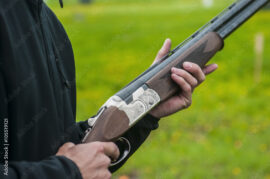
A Brief History of Shooting Competitions and Firearms
Competitive marksmanship predates not only firearms but bows and arrows: games like bocce, skittles, and cornhole emphasize accuracy, while discus, javelin, and hammer throwing emphasize range. By Medieval times, archery and crossbow competitions were famous enough to give rise to lore of Robin Hood and Wilhelm Tell. Unsurprisingly, those tales correlated deadly accuracy with personal independence.
Early Competitions
The first firearm competitions began in various South German states in late 1400s. After the 1525 Battle of Pavia, the importance of musketry was widely recognized, leading to a greater emphasis on both training of troops and technological improvements to the weapons. During the 16th century, some shooting clubs created separate categories for smoothbore and rifled arms. The same Holy Roman Emperor Maximillian I who banned wheellock guns in his domain around 1517 had an extensive collection of the same, complete with such enhancements as rifled bores, range-graduated sights, and set triggers. While mainstream military arms used matchlocks until the general transition to flintlock, wheellock guns were used extensively for personal protection and sport. They were capable of impressive accuracy, such as reliably hitting a man-sized target at 200 paces compared to 60 for smoothbore matchlock muskets.
In the American colonies, good marksmanship was a virtue forced by the dearth and expense of imported lead and powder. A typical American hunting long gun was a small-bore rifle of .32 to .36 caliber, diminishingly small compared to a typical European rifle in the .54 to .72 range. Considering the light weight of a 30-something caliber patched roundball, even with the higher muzzle velocity made possible by the caliber reduction, accuracy became vital to taking down game or stopping a foe.
As a result, shooting competitions proliferate in the 18th century, from live turkey shoots to more formal bulls-eye affairs. Free from feudal restrictions that limited the availability of firearms in Europe, Americans were generally well-armed despite the initial dependence on imports. By 1750, Pennsylvania rifles derived mainly from German designs were famous for their performance. The War of Independence further underscored the value of sniping: while not decisive in line battles, the ability to decapitate enemy units with a few accurate shots was of noted value.
Today’s Sport
Formal and widely influential shooting competitions had to wait for the mainstream acceptance of accurate rifles by the military. It’s no accident that the British Rifle Association was formed to promote marksmanship after the Crimean War of 1854-55 where .58 Enfield rifles were put to effective use against Russian troops. The guns were fine, the troops’ ability with them less than desired. The same lesson bore out of the American Secession War of 1861-65 lead to the formation of National Rifle Association in 1871. Swiss national shooting competition was formalized in 1824 but the actual event started far earlier, originally conducted with crossbows.
German Schützenfest also dates back to early Renaissance in principle but was formalized as a national event after 1871 German unification. Two types of contests arose, some using specialized sporting arms, typically single-shot and endowed with improved sights, triggers, and stocks, some with stock or slightly improved military arms. In post-WW1 Germany and post-WW2 Finland, sporting competitions with sporting-looking adaptations of military arms for biathlon and three-position competitions provided the kind of training that foreign-imposed treaties sought to prohibit. Post-1945 Finland had no snipers but plenty of biathlon enthusiasts with Mosins in fancy stocks.
In the US, the same division exists between NRA high power events that use (modified) service rifles and benchrest events. A similar division exists between Olympic pistol events with highly specialized guns firing .22 Short cartridge and bullseye, ISPC or IDPA events featuring at least theoretically carriable defensive pistol in common military calibers. Not only do the guns and the goals differ, so do the positions. One-hand bladed bullseye pistol stance and supine Creedmoor rifle firing position with the barrel resting on the shooter’s foot have little to do with military or defensive utility.
In much of the world, sports shooting is the sole legal reason for owning firearms. Many countries permit only smoothbores, others only low-power handguns, depending on what the rulers consider the greater threat to them. In yet another set of jurisdictions, centerfire rifles are available but not handguns. Air gun popularity usually rises where firearms are restricted. As a result, there’re no world-wide trends shooting competitions. At the same time that Olympics switch to laser “guns”, American and Swiss shooters develop wildcat cartridges for reaching out further with rifles.
Besides the cachet enjoyed by professional or advanced amateur athletes, shooting sports have been a driver of progress in several fields: triggers, sights, match ammunition. Military needs seldom require exceptional performance, but many of the civilian advancements later become standard military features. In case of rifles, breech loading and rifling had to wait for elongated bullets with hollow bases to become practical for field use. It’s no surprise that countries with widespread civilian gun manufacturing and ownership do better than those who rely on government development of arms and ammunition: the amount of experimentation and testing by US sports shooters vastly exceeds the resources available to even the biggest government labs.
Gunsmiths get to work with a wider variety of arms than the basics used by police and military. Despite the insane regulatory restrictions on innovation, there’s still a wide and fertile field for perfecting the classics and inventing new and better ways to shoot the same target fractionally faster or to group bullets a tenth of an inch tighter.
Written by: Oleg Volk, Firearms Photographer

